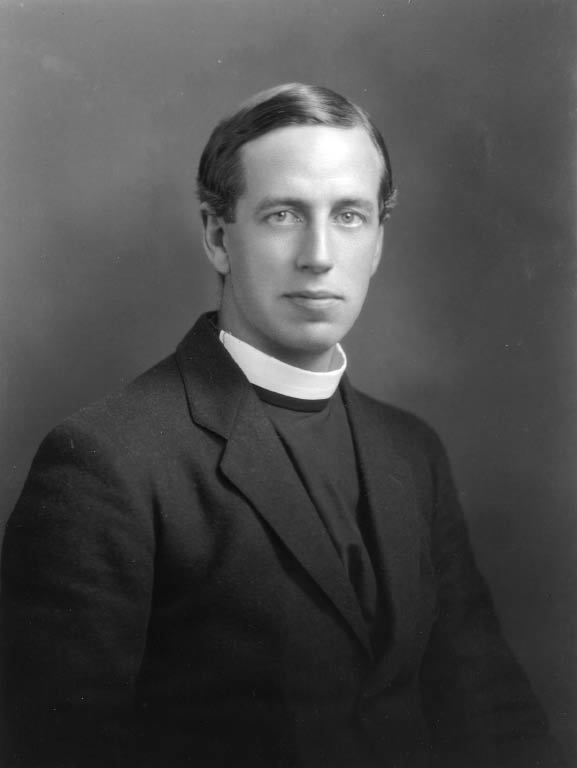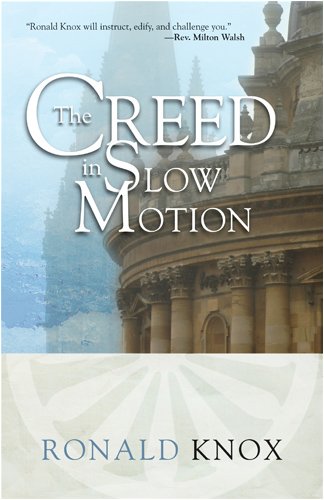“Authors Note: The sermons of which this book is composed were delivered to the girls at the Assumption Convent (now at Exton, Rutland) when they were being evacuated to Aldenham Park, Bridgnorth, during the late war.”

In 1855, the bishops of England had suggested to John Henry Newman that he should translate the Vulgate Bible into English. Because Newman was never able to produce a translation, the Bishops asked Fr. Ronald Knox, almost a century later, to take up that translation work. In 1939, Reverend Ronald Knox resigned his chaplaincy to the Catholic students at Oxford University and retreated to the country estate of friends so that he could work in quiet seclusion. Not long after his arrival, the Second World War forced the boarding school of Assumption Convent in Kensington to evacuate to the estate. “One can imagine Knox’s consternation as he watched his scholarly sanctuary invaded by a pack of schoolgirls and all his translation apparatus crowded into one small room. For the duration of the war he lived in a community of fifty-five students, fifteen nuns, and several lay staff.”
I: I Believe in God
“More and more, the longer I stay here, and the longer some of you stay here, do I find it difficult to preach to you. At Oxford, where the ordinary undergraduate lasted only three years, it was quite simple, because at the end of three years I started preaching the same sermons again….I am going to start this year by launching out on a course, and a course which will see us through more than a month of Sundays. I’m going to give an exposition, clause by clause, of the Apostle’s Creed.”

A friend of G.K. Chesterton, Knox was a sincere and charming chaplain. In the introduction, the editors inform us that Knox’s friendly conversational style and his true affection for the teenage girls earned him a special place in the hearts of his flock. If the editors are correct, the girls would routinely cut their weekend family visits short, foregoing movies and ice cream, so as not to miss his weekly chapel. Throughout these sermons, he is personable and delightfully aware of how to speak into the hearts of giddy school girls and their adult caretakers. As I read, I appreciated his style but even more than that, I appreciated what his style could do for teenagers today. I think that this book is a good fit for any mature age, but is particularly winning for young adults.
“…what religion is: a tremendous adventure which makes even this very deceptive and transitory world worth living in, because it is shot through with the glory of God and the love of Jesus Christ.” (p. 133)
Reverend Knox was ordained in the Anglican tradition in 1912. Through the writings of G.K. Chesterton and others, he converted to Roman Catholicism in 1917 and was ordained a Catholic priest in 1919. He teased and goaded Chesterton during the years between 1917 and 1922. How was it possible that Chesterton could bring Knox to Rome when Chesterton was still unconverted? Not surprisingly, Knox was a key influence and sympathetic friend during Chesterton’s long conversion process.
The Creed In Slow Motion is, as Knox explained, “an exposition, clause by clause, of the Apostle’s Creed.” Creedal Christians will have different reactions to Knox’s sermons. His style is absolutely appealing, his comments are informative, and his sincerity is convincing. The first portion of the creed is pretty commonly understood by Christians in a wide variety of traditions.
“…you are to say the Credo as an expression of your own individual point of view, giving it the full homage of your intellect, prepared to explain it to other people; if necessary, to argue it with other people.” (p. 3)
XII. Dead and Buried
Here is where things get sticky. Many Reformed and Bible Christians are likely to approach the rest of the book with varying degrees of incredulity, frustration, confusion, and doubt. I understand and respect that. I think that Knox does as well. Having been an Anglican Protestant, he has a particular sensitivity to the nuances of Roman Catholic understanding of these clauses. Knox is convinced of the truth of these claims. As a convert, he wrestled these points out before coming into the church. Therefore, his explanations are grounded in his careful discernment. He converted because the Holy Spirit moved him into belief on these points, and as a caretaker of young souls, he felt bound to help his students understand and be able to articulate their belief in these statements of faith. Knox’s preaching is clear and orthodox Catholic teaching and excellent catechesis. If you are not Catholic but desire to understand what and why Catholics believe about Purgatory, Old Testament Jews, saints, the 7 Sacraments, why Catholics are not “sola scriptura,” and aspects of Mary, this is an excellent place to start.
Conclusion
The vast majority of traditional Christians subscribe to some kind of creedal Christianity. One of the great miracles of Christianity is that, despite the chaos that Satan has caused inside our churches, and the separation that has been affected between our traditions, the Gospel remains paramount and universal to all of us. With only nuanced differences, most traditional Christians submit to the authority of the Gospel expressed not only in the text but in the distillation of that text found in the Nicene and Apostles creeds. While this book properly expresses the Catholic point of view on this universal creed, it is a beautiful exposition on the way that all Christians try to orient their entire lives toward God the Father, God the Son, and God the Holy Spirit.
“May the God of endurance and encouragement grant you to think in harmony with one another, in keeping with Christ Jesus, that with one accord you may with one voice glorify the God and Father of our Lord Jesus Christ.” – Romans 15:5
Note: I strongly recommend this particular printing of this book. Friends have acquired the kindle version and other printings, both of which lacked the notes and introduction. This is a very nice printing.
Apostle’s Creed
I believe in God, the Father Almighty, Creator of heaven and earth; and in Jesus Christ, His only Son, our Lord: Who was conceived by the Holy Spirit, born of the Virgin Mary; suffered under Pontius Pilate, was crucified, died and was buried. He descended into hell; the third day He rose again from the dead; He ascended into heaven, is seated at the right hand of God the Father Almighty; from thence He shall come to judge the living and the dead. I believe in the Holy Spirit, the Holy Catholic Church, the communion of Saints, the forgiveness of sins, the resurrection of the body, and life everlasting. Amen.
